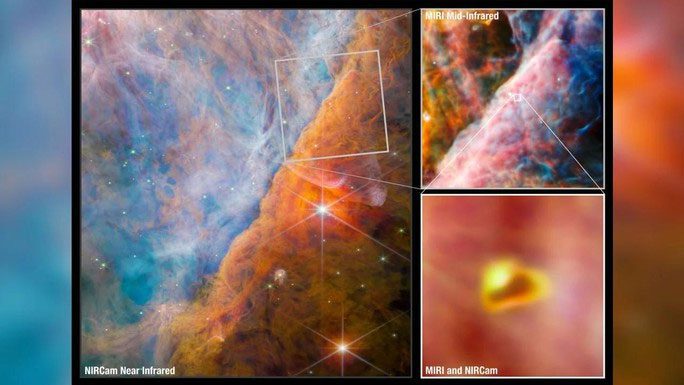An enchanting “star nursery” that can be seen in the night sky on moonless nights has revealed what might be a signal regarding the birth of Earth-like planets.
A recent statement from NASA indicates that a new “treasure” has been discovered by the James Webb Space Telescope, which is developed and operated by the agency. This treasure is the methyl cation (CH3+), located 1,350 light-years away in the Orion Nebula.
The Orion Nebula is one of the most stunning objects that can be seen with the naked eye from Earth. It is also a rare star nursery that reveals incredibly clear details under the “eye” of telescopes.

The Orion Nebula and the magnified area containing signs of impending life – (Image: NASA/ESA/CSA).
Meanwhile, CH3+ is one of the potential signs of life that scientists have always yearned to encounter. Carbon compounds form the foundation of all life forms. “Therefore, the presence of this type of carbon molecular ion is particularly significant” – a study published on Sci-News notes.
CH3+ has a unique property of being able to react diversely with other small molecules to form complex organic compounds even in the interstellar medium.
“The detection of CH3+ not only confirms the incredible sensitivity of James Webb but also affirms the significance of CH3+ in the interstellar environment” – Dr. Marie-Aline Martin from the University of Paris-Saclay (France), a member of the research team, stated.
As proven hypotheses suggest, Earth and other life-bearing planets also formed in environments with such wandering organic molecules.
This means that the Orion Nebula has the potential to create planets capable of supporting life. The ultraviolet radiation from red dwarf stars may have stimulated the production of CH3+. More complex chemical molecules from it will be seeded into newly forming planets.
If primitive life continues to successfully fend off the harmful effects of ultraviolet rays, it will emerge and evolve – possibly like Earth.
This discovery provides valuable data on how our planet acquired life.
To search for worlds that hold such wonders, try to spot the Orion constellation on clear, moonless nights. With its unique structure, the Orion Nebula will appear faintly bright when viewed with the naked eye.





















































